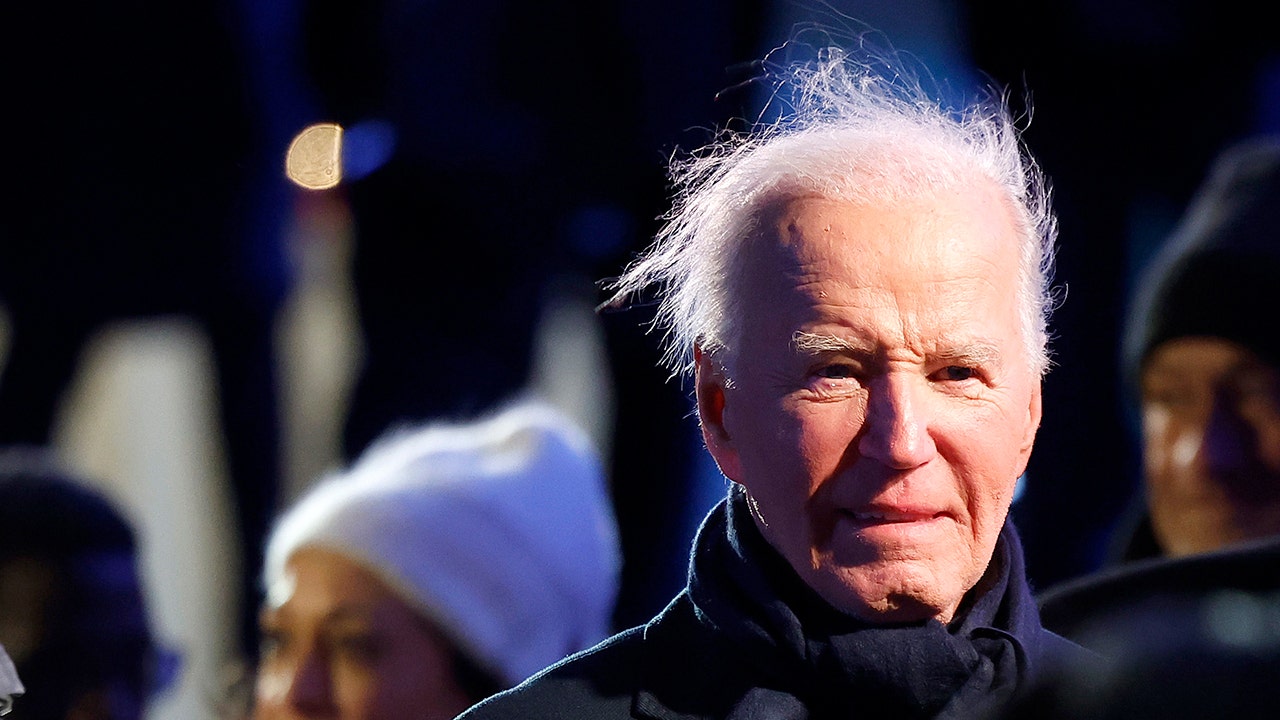Power lines lead into the coal-fired Intermountain Power Plant outside Delta, Utah. The plant, which is getting new turbines that can burn natural gas and hydrogen, is at the center of an ambitious project to cut greenhouse gas emissions.
George Frey/Getty Images
hide caption
toggle caption
George Frey/Getty Images
A couple hours south of Salt Lake City, the open desert is a hive of activity. Hundreds of workers push gravel and pull cables around low-slung green buildings. Beyond a guard shack, a stream of pickup trucks buzz along a two-lane highway that fades into sagebrush.
The workers spill into Delta, a nearby town of about 3,700. Motels and trailer parks are full. And at dinnertime, there’s a line inside El Jalisciense, a taco shop on Main Street. “If you watch the overpass, people coming into town at five and six in the evening, it’s just nonstop,” says John Niles, Delta’s mayor.
Big companies — including a major oil and gas producer — have come to this corner of Utah looking for a new way to reduce the greenhouse gas emissions that drive climate change. But even with the backing of deep-pocketed corporations, it’s hard to fund innovative projects like the hydrogen plant that’s being built near Delta. So, the developers got help from the federal government’s Loan Programs Office, part of the Department of Energy that supports groundbreaking endeavors.
The government has a long history of nurturing emerging industries and technologies, including the oil and gas drilling technique known as fracking, an early version of the internet and civilian aviation.
However, funding for cutting-edge energy projects like the one in Utah could dry up if Donald Trump is reelected. During Trump’s first term, his administration tried to strip funding from the Loan Programs Office. The agency survived, but lending slowed dramatically. Conservative activists are still pushing to eliminate the office, saying in a policy agenda called Project 2025 that the government shouldn’t back “risky business ventures or politically preferred commercial enterprises.”
Democrats take a different view. Laws signed by President Biden turbocharged the agency’s lending ability and authorized it to invest in new areas like mining for critical minerals. In general, a lot of the Biden administration’s climate spending is going to Republican-controlled states.
The debate around the Loan Programs Office underscores the stakes in this election for America’s role in developing clean energy and the future of climate action.
Without government investment in innovation, the United States would struggle to make deep cuts in climate pollution or to compete with China and other nations that are racing to dominate emerging technologies, says Tanya Das, who works on energy innovation at the Bipartisan Policy Center.
“It is very helpful for us as a society for government to be investing in technologies that better our lives,” Das says. “Because it really won’t happen otherwise.”
Electrolyzers fill a pair of warehouses in the desert near Delta, Utah. The machines make hydrogen by splitting water molecules.
Michael Copley/NPR
hide caption
toggle caption
Michael Copley/NPR
Funding innovative projects is hard, even for big companies
The Loan Programs Office was created almost two decades ago through the Energy Policy Act of 2005, which was passed by a Republican Congress and signed by President George W. Bush. At the time, energy costs were rising, and the country was increasingly dependent on foreign oil.
The legislation was shaped by lawmakers’ “competing concerns about energy security, environmental quality, and economic growth,” according to the nonpartisan Congressional Research Service. Buried in the law were instructions for the government to support innovative technology to cut air pollution and greenhouse gas emissions.
With a budget that totals less than 1% of government spending, the power of the Loan Programs Office is its ability to provide hundreds of billions in loans and loan guarantees to companies. The office has issued $42.4 billion since it started. It recently provided a loan guarantee to reopen a nuclear power plant in Michigan, and it’s lending money to build battery plants in Michigan, Ohio and Tennessee.
That support can be crucial even for big companies like the oil giant Chevron and Mitsubishi Power Americas, which are building the Utah hydrogen plant with help from a $504 million loan guarantee.
The problem companies face is that it’s hard to get a loan in the private sector to build groundbreaking infrastructure: Banks need to get paid back, and they don’t like taking a chance on something new.
“The reality of pretty much everything in this space is that it’s still very early days, and this is all about making progress” toward climate targets, says Austin Knight, vice president of hydrogen at Chevron New Energies. “And that requires policy. It requires support to get some of these new technologies off the ground and up and running so that they can compete with some of what’s already in the system today.”
Hydrogen developers found a ‘unicorn’ in the Utah desert
Chevron and Mitsubishi Power’s hydrogen plant is designed to solve a challenge that’s emerged hundreds of miles away in California, as it tries to get off fossil fuels.
California has installed more solar than any other state. Sometimes, solar panels produce more power than California needs. It happens mostly in spring, when it’s sunny but people don’t use a lot of electricity for air conditioning because temperatures are mild. That’s a problem because power grids have to keep a perfect balance between electricity supply and demand. So at certain times, California regulators cut back how much electricity solar panels produce, essentially wasting clean energy. In April alone, California “curtailed” enough renewable energy to power nearly 78,000 homes for a year.
That’s where Chevron and Mitsubishi Power come in. When California has too much renewable energy, some of the state’s utilities can send it over transmission lines to the Utah project. There, the Chevron-Mitsubishi plant will take the extra power to run machines called electrolyzers that split water molecules to make hydrogen, a fuel that doesn’t create greenhouse gas emissions when it’s burned. At about eight feet across, the electrolyzers are made of metal plates and membranes held together by huge bolts. They fill a pair of warehouses in the Utah desert.
The hydrogen, once it’s created, will be stored in underground salt caverns the size of the Empire State Building. From there, the gas can be piped to run turbines at the nearby Intermountain Power Plant, which is already hooked up to a transmission line to send electricity back to California.
Workers install solar panels on a home in California in 2023.
Sandy Huffaker/Bloomberg via Getty Images
hide caption
toggle caption
Sandy Huffaker/Bloomberg via Getty Images
The idea is to use the excess renewable energy to make hydrogen that can be stored and then used to generate and deliver power months later when electricity demand soars with hotter temperatures.
“This location, I’ve called it a bit of a unicorn,” says Sophie Hayes, who promotes clean energy in Utah for Western Resource Advocates, a nonprofit whose mission is fighting climate change. “Because it does tick a lot of boxes in terms of easing the logistical challenges of a big, pioneering hydrogen project.”
After burning coal for decades, the Intermountain Power Plant is getting new turbines that will initially run on a blend of natural gas and hydrogen. By 2045, Chevron and Mitsubishi Power say the plant will exclusively burn so-called green hydrogen, which is made with renewable energy. And as new wind and solar plants are built across the western U.S., the companies say they can expand the project.
Hayes says it’s easy for companies to say they’ll produce green hydrogen, so watchdogs need to ensure projects like this one actually run on renewable energy, not fossil fuels. But Hayes is hopeful the Utah plant will deliver.
“Hydrogen is not a panacea for replacing fossil fuels,” Hayes says. But climate change is “a huge challenge,” Hayes says, “and we need all the tools we can get.”
Piles of coal wait to be burned at the Intermountain Power Plant near Delta, Utah, in 2022.
Rick Bowmer/AP
hide caption
toggle caption
Rick Bowmer/AP
The Energy Department is still haunted by a big failure
The problem with projects like the one in Utah, according to some conservatives, is that taxpayer money is involved.
Attacks on the Loan Programs Office go back to at least 2011, when a solar panel manufacturer called Solyndra defaulted on a $535 million loan guaranteed by the Energy Department. Project 2025, the governing proposal for the next Republican administration from the Heritage Foundation, a conservative think tank, calls for eliminating the office, as well as a part of the Energy Department called the Advanced Research Projects Agency-Energy, which funds early-stage technology that has the potential to “radically improve U.S. economic prosperity, national security, and environmental well being.”
It’s one thing for the government to support “fundamental scientific research,” Project 2025 says, but it shouldn’t be “picking winners and losers in dealing with energy resources or commercial technology.”
The Trump campaign didn’t respond to requests for comment. A spokesperson for the Harris campaign declined to comment.
Trump has distanced himself from Project 2025, but dozens of its writers and architects worked in his administration. And the plan’s vision for climate and energy policy aligns with the former president’s. Both downplay threats from global warming, talk of boosting fossil fuel production and criticize government support for cleaner sources of energy.
“Where it makes sense to have new technology, we should have new technology,” says Diana Furchtgott-Roth, director of the Center for Energy, Climate, and Environment at the Heritage Foundation. “But we shouldn’t be subsidizing this new technology if it results in higher electricity prices for Americans, fewer jobs, higher food prices, and problems for small [businesses] and farmers.”
Bill Wright agrees. An elected official in Utah’s Millard County, where the hydrogen plant is being built, Wright says the development’s welcome, but he doesn’t think taxpayer money should be used for it. Government-backed projects are “profit centers for globalists,” Wright says, describing himself as “really to the right of average” in deep-red Millard, where nearly 90% of voters supported Trump in 2020. “That’s why [companies] do it. That’s the only way they can get money out of my pocket.”
Power lines run through the Utah desert near the hydrogen plant that Chevron and Mitsubishi Power Americas are building.
Micheal Copley/NPR
hide caption
toggle caption
Micheal Copley/NPR
Sitting in his backyard surrounded by alfalfa farms, Wright criticizes government subsidies of all kinds. “Solar’s terrible this way,” he says. “I like solar, but they all want a tax rebate.”
In recent years, a large share of federal energy subsidies have gone to renewables, according to the Energy Information Administration. But the country’s oil and gas industry was built up over decades with the government’s support, says John Morton, a managing director at an investment and advisory firm called Pollination and a former climate counselor to Treasury Secretary Janet Yellen.
Shifting to cleaner sources of energy promises a more affordable system for consumers than the one that exists now, according to the International Energy Agency. But that kind of change — across entire economies — requires big investments in new technology that individual companies are unlikely to make on their own, Morton says.
“We absolutely need to be leaning into this as a country and playing a leadership role by supporting our industries to move more quickly in this transition,” he says.
Sometimes that means government investments don’t work out, and that’s OK, says Das of the Bipartisan Policy Center. “That’s part of how innovation works.”
But failure is rare at projects supported by the Loan Programs Office. The agency recently reported losses of 3%.
After Solyndra, the Loan Programs Office might be best known for lending the electric-vehicle maker Tesla $465 million in 2010. Tesla repaid the loan a few years later.
Intermountain Power Agency spokesperson John Ward walks through the coal plant near Delta, Utah, in 2022.
Rick Bowmer/AP
hide caption
toggle caption
Rick Bowmer/AP
The U.S. is chasing economic development while cutting climate pollution
In Delta, Mayor John Niles is guarded about the hydrogen project. The coal plant outside town was an economic cornerstone for the city. Niles worked there for 30 years, and two sons followed him there. He’s not sure the hydrogen and gas plants will have the same impact.
“You could hire on out there right out of high school, they would teach you your skill while paying you a good wage,” Niles says in his office at Delta’s municipal building, next to the town’s only stoplight. “And that, to me, has been a lifesaver for our community, for our young people.”
The hydrogen plant will have about 20 full-time workers, according to an environmental assessment. And the gas plant will employ around 120 more, compared to about 300 at the coal plant, John Ward, a spokesperson for the Intermountain Power Agency, the plant’s owner, said in an email. Utah’s Republican-led government is trying to keep the coal units running, but it’s unclear how those efforts will play out.
“We are doing everything we can from a hiring standpoint,” says Michael Ducker, chief executive of MHI Hydrogen Infrastructure, a subsidiary of Mitsubishi Power Americas. “In the long run, we’re looking at different opportunities for scaling out this hydrogen hub” to deliver more economic benefits.
As communities like Delta wrestle with lost coal jobs, they also face worsening impacts from climate change. Last year was the hottest on record, this year will be among the five hottest, and scientists warn the next decade will be hotter still. Utah endured record heat this summer, a hallmark of human-caused global warming. At a recent meeting of local officials from around the state, Niles says there was a lot of talk about water shortages.
“They actually can’t grow, because [there’s] no water,” he says. Delta has reserves, “but we need another well,” Niles says, “because our wells right now are running 24/7 when it’s this hot.”
Chevron and Mitsubishi Power Americas will take renewable energy from California to run electrolyzers inside these green buildings in the Utah desert.
Michael Copley/NPR
hide caption
toggle caption
Michael Copley/NPR
The Environmental Protection Agency expects that in the coming decades, rising temperatures will reduce the flow of water on Utah’s rivers, raise the threat of wildfires and make farms and ranches less productive.
With that outlook, Jigar Shah, director of the Loan Programs Office, says his agency will work with anyone who has a credible plan to deal with the challenge, including fossil fuel companies that are distrusted by climate activists.
“I totally understand why the track record of some of these companies would be offensive to some of these groups,” Shah says. “But from our perspective, we are solving the toughest problem that, frankly, the human species has today. That means every single super-smart person in our entire country gets to play.”
With two months to go before an election that could shake up U.S. energy and climate policy, Shah sounds upbeat. The Inflation Reduction Act, a 2022 landmark climate law, is driving big investments in Republican-led states. And Shah says there’s a line of companies at his door looking for help funding ambitious energy projects.
“That makes me excited,” Shah says, “about the economic growth potential in our country.”


























/cdn.vox-cdn.com/uploads/chorus_asset/file/25782636/247422_ChatGPT_anniversary_CVirginia.jpg)
/cdn.vox-cdn.com/uploads/chorus_asset/file/25789444/1258459915.jpg)

/cdn.vox-cdn.com/uploads/chorus_asset/file/25546252/STK169_Mark_Zuckerburg_CVIRGINIA_D.jpg)


/cdn.vox-cdn.com/uploads/chorus_asset/file/23951353/STK043_VRG_Illo_N_Barclay_3_Meta.jpg)